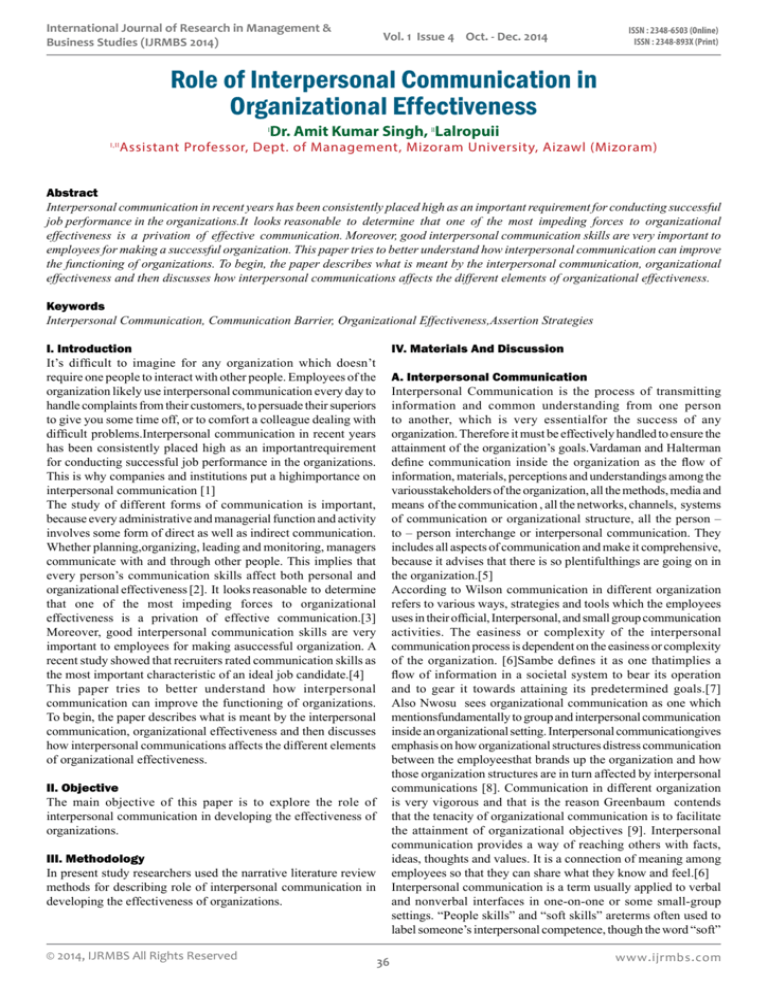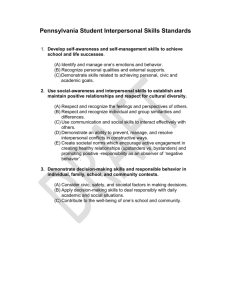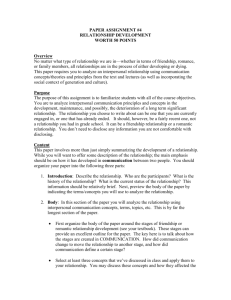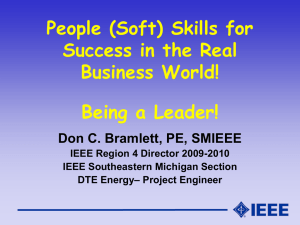
International Journal of Research in Management &
Business Studies (IJRMBS 2014)
Vol. 1 Issue 4 Oct. - Dec. 2014
ISSN : 2348-6503 (Online)
ISSN : 2348-893X (Print)
Role of Interpersonal Communication in
Organizational Effectiveness
Dr. Amit Kumar Singh, IILalropuii
I
I,II
Assistant Professor, Dept. of Management, Mizoram University, Aizawl (Mizoram)
Abstract
Interpersonal communication in recent years has been consistently placed high as an important requirement for conducting successful
job performance in the organizations.It looks reasonable to determine that one of the most impeding forces to organizational
effectiveness is a privation of effective communication. Moreover, good interpersonal communication skills are very important to
employees for making a successful organization. This paper tries to better understand how interpersonal communication can improve
the functioning of organizations. To begin, the paper describes what is meant by the interpersonal communication, organizational
effectiveness and then discusses how interpersonal communications affects the different elements of organizational effectiveness.
Keywords
Interpersonal Communication, Communication Barrier, Organizational Effectiveness,Assertion Strategies
I. Introduction
It’s difficult to imagine for any organization which doesn’t
require one people to interact with other people. Employees of the
organization likely use interpersonal communication every day to
handle complaints from their customers, to persuade their superiors
to give you some time off, or to comfort a colleague dealing with
difficult problems.Interpersonal communication in recent years
has been consistently placed high as an importantrequirement
for conducting successful job performance in the organizations.
This is why companies and institutions put a highimportance on
interpersonal communication [1]
The study of different forms of communication is important,
because every administrative and managerial function and activity
involves some form of direct as well as indirect communication.
Whether planning,organizing, leading and monitoring, managers
communicate with and through other people. This implies that
every person’s communication skills affect both personal and
organizational effectiveness [2]. It looks reasonable to determine
that one of the most impeding forces to organizational
effectiveness is a privation of effective communication.[3]
Moreover, good interpersonal communication skills are very
important to employees for making asuccessful organization. A
recent study showed that recruiters rated communication skills as
the most important characteristic of an ideal job candidate.[4]
This paper tries to better understand how interpersonal
communication can improve the functioning of organizations.
To begin, the paper describes what is meant by the interpersonal
communication, organizational effectiveness and then discusses
how interpersonal communications affects the different elements
of organizational effectiveness.
IV. Materials And Discussion
A. Interpersonal Communication
Interpersonal Communication is the process of transmitting
information and common understanding from one person
to another, which is very essentialfor the success of any
organization. Therefore it must be effectively handled to ensure the
attainment of the organization’s goals.Vardaman and Halterman
define communication inside the organization as the flow of
information, materials, perceptions and understandings among the
variousstakeholders of the organization, all the methods, media and
means of the communication , all the networks, channels, systems
of communication or organizational structure, all the person –
to – person interchange or interpersonal communication. They
includes all aspects of communication and make it comprehensive,
because it advises that there is so plentifulthings are going on in
the organization.[5]
According to Wilson communication in different organization
refers to various ways, strategies and tools which the employees
uses in their official, Interpersonal, and small group communication
activities. The easiness or complexity of the interpersonal
communication process is dependent on the easiness or complexity
of the organization. [6]Sambe defines it as one thatimplies a
flow of information in a societal system to bear its operation
and to gear it towards attaining its predetermined goals.[7]
Also Nwosu sees organizational communication as one which
mentionsfundamentally to group and interpersonal communication
inside an organizational setting. Interpersonal communicationgives
emphasis on how organizational structures distress communication
between the employeesthat brands up the organization and how
those organization structures are in turn affected by interpersonal
communications [8]. Communication in different organization
is very vigorous and that is the reason Greenbaum contends
that the tenacity of organizational communication is to facilitate
the attainment of organizational objectives [9]. Interpersonal
communication provides a way of reaching others with facts,
ideas, thoughts and values. It is a connection of meaning among
employees so that they can share what they know and feel.[6]
Interpersonal communication is a term usually applied to verbal
and nonverbal interfaces in one-on-one or some small-group
settings. “People skills” and “soft skills” areterms often used to
label someone’s interpersonal competence, though the word “soft”
II. Objective
The main objective of this paper is to explore the role of
interpersonal communication in developing the effectiveness of
organizations.
III. Methodology
In present study researchers used the narrative literature review
methods for describing role of interpersonal communication in
developing the effectiveness of organizations.
© 2014, IJRMBS All Rights Reserved
36
www.ijrmbs.com
ISSN : 2348-6503 (Online)
ISSN : 2348-893X (Print)
International Journal of Research in Management &
Business Studies (IJRMBS 2014)
Vol. 1 Issue 4 Oct. - Dec. 2014
seems to be an inappropriate word to describe skills which can
potentially cost you your job. If viewed from another perspective,
that these should be “hard” skills too because they are difficult to
learn and their impact on your career and personal life is huge.
In the workplace, one who is very good in interpersonal
communication can report to and work with a wide variety of
people,handle conflicts, negotiate differences, make requests
effectively andreceive information objectively. A person who is
effective in interpersonal communication willbe open to the ideas
of other employees and willing to put forward their views of
essentialactivities in the process of problem solving.
Interpersonal communication effectively works on four basic
principles. These principles inspire the workings in real life of
interpersonal communication. They are basic to interpersonal
communication and play great importance in building the
effectively of organizations. These principles are• Interpersonal communication is inescapable
• Interpersonal communication is irreversible
• Interpersonal communication is complicated
• Interpersonal communication is contextual
In other words, communication does not occur in isolation. There are
different context of communication. One of them isPsychological
context, which describethe existence of employees and what
they bring to the interaction. Employee’s desire, needs, values,
personality, etc., all may be consideredform psychological context.
Another framework is Relational, which concernsemployee’s
reactions to the other employees. The Situational context deals
with the psycho-social "where" people are communicating. An
interaction that takes place in one organization will be very
different from other that takes place in different organizations.
Environmental context deals with the physical "where “employees
communicate. Furniture, noise, location, level, season, temperature,
time of day, these are considered asexamples of environmental
context.Cultural context includes all the scholarly behaviors and
instructions that affect the interaction. One can from a culture
where it is considered insolent to make long, direct eye contact;
one will out of respectto avoid eye contact. If the other employee
comes from a different culture where long, direct eye contact
signals are reliable, then one should in the cultural context for a
basis for misunderstanding. [10]
designation of functions often pointers to misuse of functional
authority in the organizations. Functional authority should
be delegated toa suitably designated employee based on the
departmental policy. The manager must be trained, educated
and with experience, his level of honesty must be high
and authentic and must be judgmental in his dealing with
everyone.[11]
Wilson [6] brought out the following facts as barrier to effective
communication in different types of organizations.
• Physical setting of office
• Clothes
• Timing of the message
• Lack of rapport between the sender and receiver
• Lack of motivation
• Non-payment of salaries
As it is with all social activities, organization cannot run
well without effective interpersonal communication. For any
organization to recognize its set organizational goal there must
be rich and free drive of interpersonal communication, operative
organizationalobjectives will be achieved also if these obstacles
are met and face-toface interface is the most advantageous to
the employees in the organization than the written documents.
Interpersonal communication has the advantage of providing
feedback and the opportunity of understanding the message more
appropriately in this global economic age.
C. Organizational Effectiveness
The American Public Human Services Association (APHSA)
definesOrganizational Effectiveness as systemic approach
for continuously improving an organization’s performance,
organizations ‘performance capacity and client outcomes. APSHA
refers “Systemic” to taking into account the complete system or
in the case of organizational effectiveness an entire organization;
“systematic” refers to captivating a step‐by‐step approach. In
simple terms, Organizational Effectiveness is a step‐to‐step
approach for continuously improving the whole organization.
In the Organizational Effectiveness approach, effective
organizations are described as operating systems that are made
up of the different interconnected moving parts, such as the aim of
the organizational strategy shared and perceived as important by
the employees within the organization and stakeholders opinion
to the organization; resources placed into the organization to
achieve the organizational strategy ; ability of the organization
to advance toward outcomes using available resources for
assessing performance capacity of organizations; activities of
the organization towards(performance actions; results of system
performance ; changes in lives as a result of outcomes; and
feedback from clients, staff, partners, key other stakeholders, and
the community about how well the organization is achieving its
desired outputs and outcomes from the environment. Feedback
helps in continuous improvement of organizational strategy.
This motivates continuous improvement of performance, inputs,
capacity, and performance actions, for continuous improvement
of outputs and outcomes.
Strategy work involves defining the aim and game plan of the
organization.What the organization is, what it plans to do and why,
how it will plan to do it, and what it requires to succeed. Structure
and culture work contains modeling values and significant and
communicating departments, levels, jobs, work teams, policies, and
desired performance. Key work processes involve defining definite
processes and procedures that explain strategy and anticipated
B. Barriers to Effective Organizational Communication
Some barriers of organizational communication have been
identified as they affect the effectiveness of organizational. These
barriers include:
1. Lack of clarity: Failure to use common language and honest
expressions
2. Lack of proper coordination: Organizational Failure to
coordinate the various activities of the different departments
in the organization frequently results in pitiableinterpersonal
communication, repetition of effort and regular irritation
and frustration for the employees affected. Proper channel
of interpersonal communication in organization has to be
followed for improving the organizational productivity.
3. Lack of adequate organizational equipment: Lack of
necessary communication facilities can significantlyhamper
the proper functioning of a business environment in the
organization. Interpersonal organizational communication
remains effective when all the required facilities are put in
the organization and the employees are trained.
4. Improper description of functions: Undefined and unclear
www.ijrmbs.com
37
© All Rights Reserved, IJRMBS 2014
International Journal of Research in Management &
Business Studies (IJRMBS 2014)
Vol. 1 Issue 4 Oct. - Dec. 2014
structure and culture into direction for day-to-day work. Operations
work comprisesrealizing key processes, providing services to
customers, and managing employee’s performance. [12]
organizational performance.Long-term study of Fortune 1000
firms shows positive trends in use ofemployee involvement
programs within these organizations, along with increasing
number of employee participation in employee involvement
programs. [12]
The key point of interpersonal communication is assertion, thus the
most criticaltactics in effective interpersonalcommunication are
assertion strategies.These are the means that supportemployees to
maintain their respect, satisfy their needs, and defend their rights
without manipulating, dominating, abusing, or controlling others.
It is important for organization to make their employees familiar
with these strategies in demand to develop their skills and attitude
in effective interpersonal communication. Effective interpersonal
communication requires other employees to do something, perhaps
to change their own behavior or to ask them to do things for
others. Because of this, a dedication among employees comes
from high degree of self-esteem and an acceptance of oneself.As
everyone is not able to assert herself or herself and get the other
to do something.
Appropriate interpersonal communication thus is making explicit
what organizational employees think about other employees of the
organizations. It recognizestheir rights as specific and the rights
of other employees also. When it requires, an employee expert in
interpersonal communication can stand up for their rights, disagree
and present another points of view without being unsettled or
putting the other employeesdepressed. In contrast, an employee
weak in interpersonal communication feels threatened in such
situations and behaves with aggressive rather than with assertive
behavior. [13]
D. Major Challenges to Organizational Effectiveness
The challenge for businesses organizations seems simple: align
and engage employee’s workforce to a clearly expressed strategy.
However, this can be a challenge to attain. It requires a complete,
coordinated effort to put a large number of building blocks or key
elements in place. The key elements of organizational effectiveness
are needed to motivate employee engagement in the organizations.
Employee engagement influences the clients’ experience and,
ultimately, the complete performance of an organization in terms
of efficiency and profitability.
The performance of organizations is measured on the basis of
outcome or the delivery of services. Different studies revealed
that many business leaders struggle to bring into line and engage
employees with the organization’s strategy for making organization
successful. So it is important to understand how do businesses
achieve sustainable organizational effectiveness? As it is identified
that, a key element is to align organizational employees with the
organization’s strategy by helping employees to understand the
role they play in achieving success, and placing employees on
their jobs with the organization. Alignment of strategy is achieved
through a “fit-for objective” structure, talented leadership, and
operative people systems and culture. Integrating efforts through
these areas will lead to more extremely engaged employees
who are enthusiastic and capable of serving the organization to
achieve its goal. However, justifiable organizational effectiveness
needsimportant attention be paid to all of these elements. Focusing
attention on just one element without the others will not provide
long-term engagement. [13]
There are a number of processes that need to be in place to ensure
leaders are supported to take action and that the right changes
occur and are embedded within the organization.
These processes include:
o Communication process that reaches all key stakeholders
and clearly covers the why, what, when, and how.
o Developmental process to ensure leaders has the knowledge
and skills to take action.
o Leadership support that ensures resources and energy are
aligned with the strategy.
o Process for communicating the findings quickly and
transparently.
o Process for effectively cascading engagement initiatives
throughout the entire workforce.
o Process for measuring success and return on investment.
o Process for business leaders to report progress and draw
ideas and support from their leader and peers.
V. Conclusion
Communication is the process of transmitting information and
common understanding from one person to another. Every
organization, regardless of industry or country, seeks to be
more effective and achieve superior results. Business strategy
is developed to achieve this. Execution occurs when structure,
roles, capability, leadership, systems, and culture are all pulling
together and aligned with the strategy. One without the other will
create misalignment and success will not be realized.The main
consideration to this study is the capture of respondents’perceptions
of effectivenessof interpersonal communication at a single point
in time.The organizations performance depends on leader’s
interpersonalskill in change implementation overthe life of an
organizational affectivity.This paper identify that key point of
interpersonal communication is assertion, thus the most critical
tactics in effective interpersonal communication are assertion
strategies. The people strong in interpersonal communicationcan
stand up for their rights, disagree and present different points of
view without intimation or putting the other employees down for
making the organization more effective.
E. Inter Personal Communication and Organizational
Effectiveness
Interpersonal Communication can be an effective tool for
motivating employeesof the organization involved invarious
activities. Appropriate communications provideemployees with
feedback and reinforcement during the effective organizational
change [14]. The effective organizational change, for increasing
organizational affectivity, enablesemployees to make better
decisions and preparesthem for the advantages and disadvantages
of change [15]. Employee involvement in various organizational
activity increases employees input into decisions which affects
© 2014, IJRMBS All Rights Reserved
ISSN : 2348-6503 (Online)
ISSN : 2348-893X (Print)
Reference
[1] Centre for English Language Communication
National University of Singapore (2011).Interpersonal
Communication.Singapore:Author
[2] Brun, J. P. (2010). Missing pieces: 7 ways to improve
employee well-being and organizational effectiveness.
New York, NY: Palgrave Macmillan.
[3] Lutgen-Sandvik, P. (2010). Destructive organizational
communication: Processes, consequences, and constructive
ways of organizing. New York, NY: Routledge.
38
www.ijrmbs.com
ISSN : 2348-6503 (Online)
ISSN : 2348-893X (Print)
International Journal of Research in Management &
Business Studies (IJRMBS 2014)
Vol. 1 Issue 4 Oct. - Dec. 2014
[4] Yate, M. (2009). Hiring the best: A manager’s guide to
effective interviewing and recruiting. Cincinnati, OH: F &
W Media.
[5] Vardaman, G &Halterman, C. (1968). Managerial control
through communication. New York: John Wiley & sons.
[6] Wilson, D. (2005). New perspectives in applied
Communication. Ibadan: SterlinHordan Publishers
[7] Sambe, J.A (2005). Introduction to mass communication
practice in Nigeria. Ibadan: spectrum Books Ltd.
[8] Nwosu, I &Ekwo, U. (1990).Mass Media and Marketing
Communications.(Principles, perspectives and practices).
Enugu: Dek Computer Technologies.
[9] Greenbaum, H.(1974). The Audit of organizational
communication, Academy of Management Journal. Pp73954
[10] Lunenburg, F.C,& Irby, B. J. (2006). The principalship:
Vision to action. Belmont, CA: Wadsworth/Cengage.
[11] Organizational Change: Motivation,Communication,
and LeadershipEffectiveness Ann Gilley, Jerry W. Gilley
and Heather S. McMillanEffectiveness of Organizational
Communication in the Global Age
[12] American Public Human Service Association (2012).A
Guidebook for Building Organizational Effectiveness
Capacity: A Training System Example, Washington, DC:
Author
[13] Organizational Effectiveness (http://www.right.com/
thought-leadership/research/ organizational-effectivenessdiscovering-how-to-make-it-happen.pdf accessed on 22nd
November 2014)
[14] Peterson, D. B., & Hicks, M. D. (1996).Leader as coach:
Strategies for coaching and developing others. Minneapolis:
Personnel Decisions International.
[15] Saunders, R. (1999). Communicating change.Harvard
Management Communication. Letter, 8(1), 35–36.
Authors Profiles
Dr. Amit Kumar Singh is assistant professor in the department of
Management, Mizoram University, Aizawl. He got his education
from BHU, Varanasi, VBS PU Jaunpur and IIM Ahmedabad.
He has published 1book and more than 35 research papers in
International/National journals and edited books. He also served
as member of different academic bodies like BOS, School Board,
Academic Council (as Head i/c), etc. Currently he is in the advisory
board of 12 International journals. Dr. Singh is also working
as Japan International Co-operation Agency (JICA) service
consultant for department of Forest, Government of Mizoram.
Lalropuii is assistant professor in the department of Management,
Mizoram University, Aizawl. Her area of teaching is Finance and
Managerial Skill development. She is pursuing her Ph.D in the
area of Public Distribution System.She also served as member
of different academic bodies like BOS and School Board.She is
also programme officer of NSS Mizoram University unit and office
bearerf Mizoram University Alumni Association.
www.ijrmbs.com
39
© All Rights Reserved, IJRMBS 2014






